MSTE Terms
1/150
There's no tags or description
Looks like no tags are added yet.
Name | Mastery | Learn | Test | Matching | Spaced |
|---|
No study sessions yet.
151 Terms
Benching
A method of protecting workers from cave-ins by excavating the sides of an excavation to form one or a series of horizontal levels or steps, usually with vertical or near vertical surfaces between levels.
Sloping
It involves cutting back the trench wall at an angle inclined away from the excavation.
Shoring
It requires installing aluminum hydraulic or other types of supports to prevent soil movement and cave-ins.
Shoring
A temporary support system used in construction to provide temporary structural support to an existing structure or excavation. It is typically used to prevent collapse or instability during construction work, such as excavation, demolition, or renovation of a building.
Shielding
It protects workers by using trench boxes or other types of supports to prevent soil cave-ins.
Scaffolding
The use of any temporary elevated platform for supporting employees or materials or both in the course of any construction works.
Screeding
The action of flattening poured concrete into a smooth, flat layer prior to finishing the surface.
Screeding
To level a floor or layer of concrete with a straight edge using a back-and-forth motion while moving across the surface.
Trowelling
A finishing technique used in concrete construction to smooth and level the surface of freshly poured concrete.
Floating
It is a concrete finishing process where a large, flat-bladed tool called a float is used to level and smooth the surface of freshly poured concrete.
Floating
It is typically done after the initial screeding process to remove any surface imperfections and consolidate concrete surface.
Finishing
It refers to the stage in which the surface of the concrete is treated to achieve the desired appearance texture and durability.
Floating
It is a concrete finishing process where a large, flat-bladed tool called a float is used to level and smooth the surface of freshly poured concrete.
Slump Test
The test for the relative consistency of the concrete.
Floating
It is typically done after the initial screeding process to remove any surface imperfections and consolidate concrete surface.
Drip Track Raveling
Progressive disintegration of the surface between the wheel paths caused by dripping of gasoline or oil from vehicles.
Flushing
The extruding of bitumen onto the pavement surface, causing a reduction in skid resistance. It is generally caused by excessive amounts of asphalt in the mix or low air voids content. It occurs when asphalt fills the voids in the mix during hot weather and then exudes out onto the surface of the pavement.
Faulting
Elevation differences between adjacent slabs at transverse joints. It is usually the result of pumping and is a major source of Portland Concrete pavement structure.
Trowelling
A finishing technique used in concrete construction to smooth and level the surface of freshly poured concrete.
Joint Spalling
The deterioration or breaking of concrete at joints or cracks due to the effect of traffic loading, temperature changes, and freeze thaw cycles.
Blowups
Localized upward buckling and shattering of the slabs at transverse joint or cracks. They can occur when transverse joints are filled with incompressible solid materials.
Alligator Cracking
A series of interconnected or interlaced cracks caused by fatigue failure of the asphalt concrete surface under repeated traffic loading.
Block Cracking
Cracks forming large interconnected polygons, usually with sharp corners or angle. These cracks are generally caused by hardening and shrinkage of the asphalt and or reflection cracking from underlying layers such as cement-treated base.
Shielding
It protects workers by using trench boxes or other types of supports to prevent soil cave-ins.
14
The number of days final curing for a concrete cement pavement is done for.
Screeding
The action of flattening poured concrete into a smooth, flat layer prior to finishing the surface.
Excavation
Any man-made cut, cavity, trench, or depression in the Earth's surface formed by earth removal.
Type C
Benching cannot be done in Type ___ soil.
Trench
A narrow excavation (in relation to its length) made below the surface of the ground.
Equilateral Triangle
Standard sign shape for "Give Way" sign.
Circle
Standard sign shape for regulatory signs.
Circle
Standard sign shape for additional information.
Rectangle
Standard sign shape for directional signs, roadwork signs, signs for special purposes, and supplementary plates for warning signs.
Rectangle
Standard sign shape for facility information signs, instruction signs, guide signs and destinations of point of interest.
Equilateral Triangle
Standard sign shape for warning signs.
Pentagon
Standard sign shape for pedestrian and school crossing sign.
Risk
The probability of harm actually being done.
Hazard
Anything that can cause harm.
Incident
An instance of something happening, an unexpected event or occurrence that doesn’t result in serious injury or illness but may result in property damage.
Accident
An unexpected event which results in serious injury or illness of an employee and may also result in property damage.
Unsafe Act
It is a violation of an accepted safe procedure which could permit the occurrence of an accident.
Unsafe Condition
A hazardous physical condition or circumstance which could directly permit the occurrence of an accident.
Vicinity Map
It is advisable for a site plan to contain a large-scale map of the overall area and to indicate where the project is located on the site.
Specifications
It provides the detailed requirements for the materials, equipments and workmanship to be incorporated into the project.
Profile
This drawing has elevation as its vertical axis and horizontal distance as measured along the centerline of the facility (or other reference line) as its horizontal axis.
Geometric Cross Section
This drawing has elevation as its vertical axis and horizontal distance, as measured perpendicular to the centerline, as its horizontal axis.
Geometric Design
It refers to the establishment of horizontal and vertical alignments and cross-section, based on considerations such as operating characteristics of vehicles, design standards and drainage.
Traffic Density
It is defined as the number of vehicles per unit distance occupying a section of roadway at a given instant time.
Traffic Volume
The number of vehicles moving in a specified direction on a given lane or roadway that pass a given point during specified unit time.
Traffic Capacity
The ability of a roadway to accommodate traffic volume. It is expressed as the maximum number of vehicle in a lane or a road that can pass a given point in unit time.
Basic Capacity
The maximum number of passenger cars that can pass a given point on a lane or roadway during one hour under the most nearly ideal roadway and traffic conditions which can possibly be attained.
Possible Capacity
The maximum number of passenger cars that can pass a given point on a lane or roadway during one hour under prevailing roadway and traffic conditions.
Practical Capacity
The maximum number of passenger cars that can pass a given point on a lane or roadway during one hour without traffic density being so great as to cause unreasonable delay, hazard, or restrictions to the driver’s freedom to maneuver under traffic conditions.
Number of Traffic Lanes
The design element most affected by the volume of traffic.
Traffic Signs
Device mounted on a fixed support (permanent signs) or portable support (temporary signs) whereby a specific message is conveyed by means of words or symbols placed or erected for the purpose of regulating, warning or guiding traffic.
Regulatory Signs
Signs that inform road users of the traffic laws and regulations which if disregarded will constitute an offense.
Special Instruction Signs
Signs that instruct road users to meet certain traffic rule requirements on road condition.
Warning Signs
Signs which warn road users of condition on or adjacent to the road maybe unexpected or hazardous.
Roadwork Signs
Signs which warns or advise temporary hazardous conditions that could endanger road users or the men and equipment engaged on roadworks.
Overhead Signs
Signs which provide means of displaying essential traffic information on wide multi-lane roads, where some degree of lane use control is required or where side of road clearance is insufficient to accommodate a road side sign.
Guide Signs
Signs which inform and advise road users of directions, distances, routes and the location of services for road users and point of interest.
Guide Signs
Signs that inform road users about the direction and distances of destinations on the route they are following or along other roads that intersect their route.
Chevron Signs
Signs used to guide drivers through a change in horizontal alignment of the road.
Expansion Joint
Joints placed in concrete pavements, which are usually placed transversely, at regular intervals, to provide adequate expansion space for the slab to expand when the pavement is subjected to an increase in temperature.
Contraction Joint
Joints placed in concrete pavements, which are usually placed transversely regular intervals across the width of the pavement to release some of the tensile stresses that are due to a decrease in temperature.
Construction Joint
Joints placed in concrete pavements, which are usually placed transversely across the pavement width to provide suitable transition between concrete placed at different times or on different days.
Transverse Joint
Joints placed in concrete pavements at right angles to the center line of the pavement.

Rumble Strips
It is a type of thermoplastic lane marking designed to aid and provide motorist with visual, audio, and warning on the road.
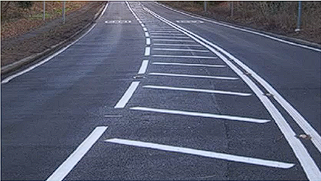
Diagonal Markings
Markings which are placed on sealed shoulders or other sealed portion of the road where traffic is not desired.
Chevron Markings
They are often used to guide traffic into the right turning lanes separated by an island, such as a corner island at a signalized intersection.
2.5
The reaction time used for road safety design is ___ seconds.
80 or 90 kph
The speed limit appropriate on lower standard expressways.
2000 veh/hr
Ideal capacity of a road.
3.35 m
The basic lane width appropriate for national roads.
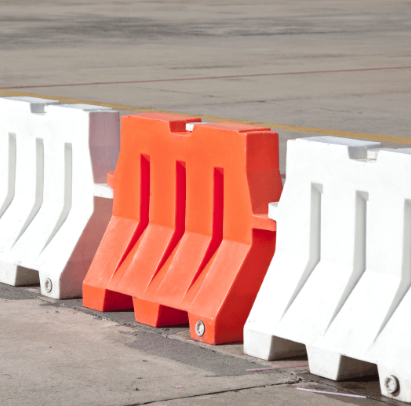
Barriers
Highway appurtenances designed to prevent vehicular penetration from the travelway to areas behind them such as to minimize damage to impacting vehicles and their occupants, and to reduce the risk of injuries to pedestrians and workers.

Flashing Lamps
Warning devices used to supplement other controls and devices necessary to alert motorists of construction and maintenance activities or obstructions in the roadway.
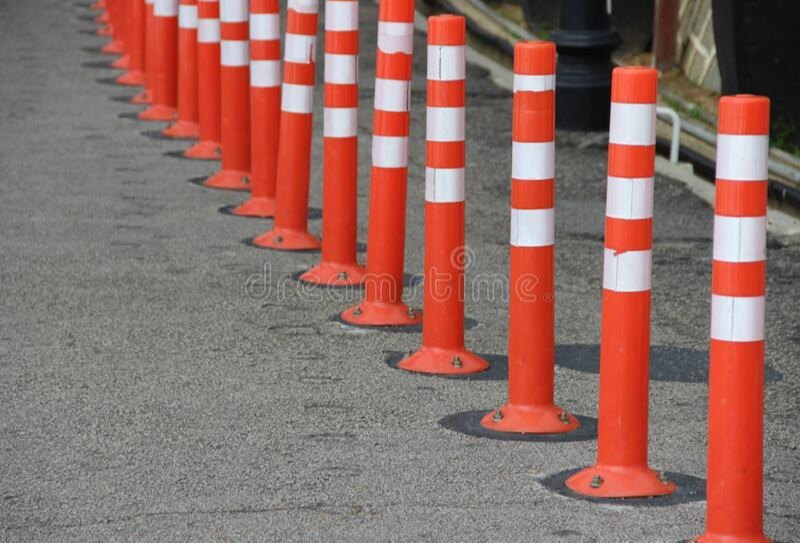
Delineators
Light retro-reflecting devices mounted at the side of the roadway, in series, to indicate the roadway alignment.

Traffic Cones
Devices which may be conical in shape or tubular shaped capable of performing channelization of traffic which may be set on the surface of the roadway or rigidly attached for continued use.
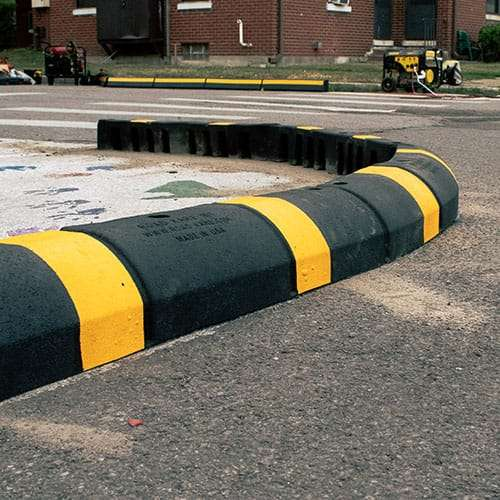
Temporary Curbing
Roadwork devices consisting of precast concrete sections, sandbag and others which may be used to guide traffic at the construction site.
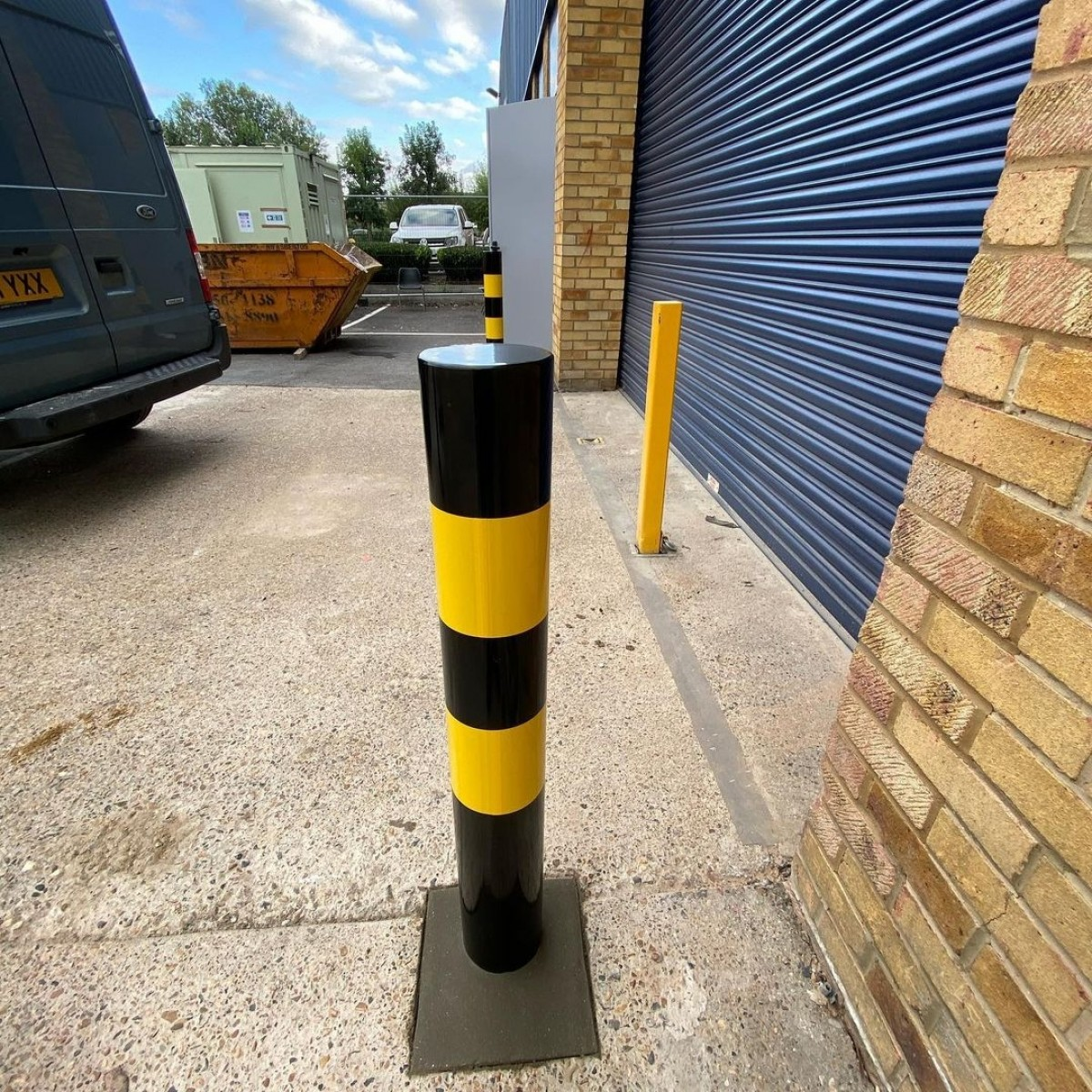
Flexible Post/Bollard
Device used in place of rigid cones with a minimum of 450 mm by 50 mm wide with alternate bands of contrasting color as seen by approaching traffic for delineation of traffic.
Road Markers
Any traffic control device marked on the surface of the carriageway used to regulate traffic or to warn or guide road users.
Risk Assessment
Looking at the possibility of injury or harm occurring to a person if exposed to a hazard.
Hazard Identification
Recognizing of things which may cause injury or harm to a person.
Risk Control
Introduction of measures which will eliminate or reduce the risk of a person being exposed to a hazard.
Rule 1080
Rule ___ is the guidelines regarding Personal Protective Equipment (PPE).
Shallow Water Wave
Waves occurring in water having a depth less than half its wavelength (d<L/2).
Deep Water Wave
Waves occurring in water having a depth greater than half its wavelength (d>L/2).
Long wave
Waves having a depth less than 1/25 of its wavelength.
Significant Wave
The average height of the highest one-third of waves in wave train.
Highest One-Tenth Wave
The wave whose height and period are equal to the mean height and period of the highest one-tenth of the waves in a wave group.
Highest Wave
A maximum wave height and wave period of the maximum wave height in the wave train.
Gravity Wave
Waves formed by the frictional drag of wind across the water surface.
Clapotis
The pressure against a vertical wall due to waves.
Mean Wave
The wave whose height and period are equal to the mean height and period of all of the waves in a wave group.
Equivalent Deep Water Wave
It is a hypothetical wave height that has been corrected for the effects of planar topographic changes such as refraction and diffraction; it is expressed with the significant wave height.
Seiches
They are typically caused when strong winds and rapid changes in atmospheric pressure push water from one end of a body of water to the other.
Seiches
A very long standing wave on a large but limited body of water generally occurring when a storm dies down after producing a wind tide.
Swells
They are a group of short-period ocean waves created by the wind blowing above the ocean close to the shore.
Tide
The regular periodic rise and fall of the surface of the seas, observable along their shores.
Spring Tide
In many parts of the world, the high waters reach their greatest height and the low waters at the least height, soon after the time of full moon and new moon. These tides are called: